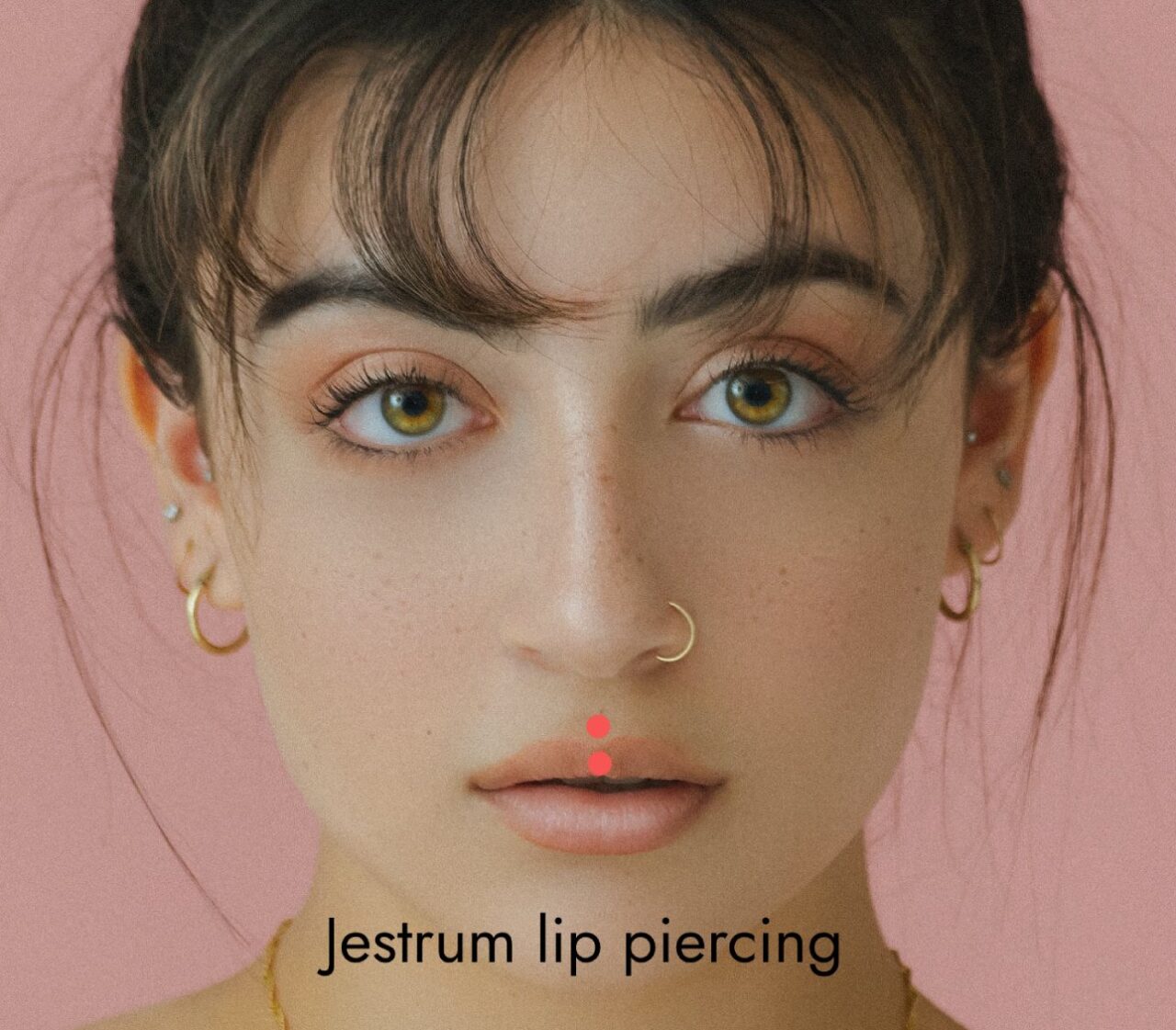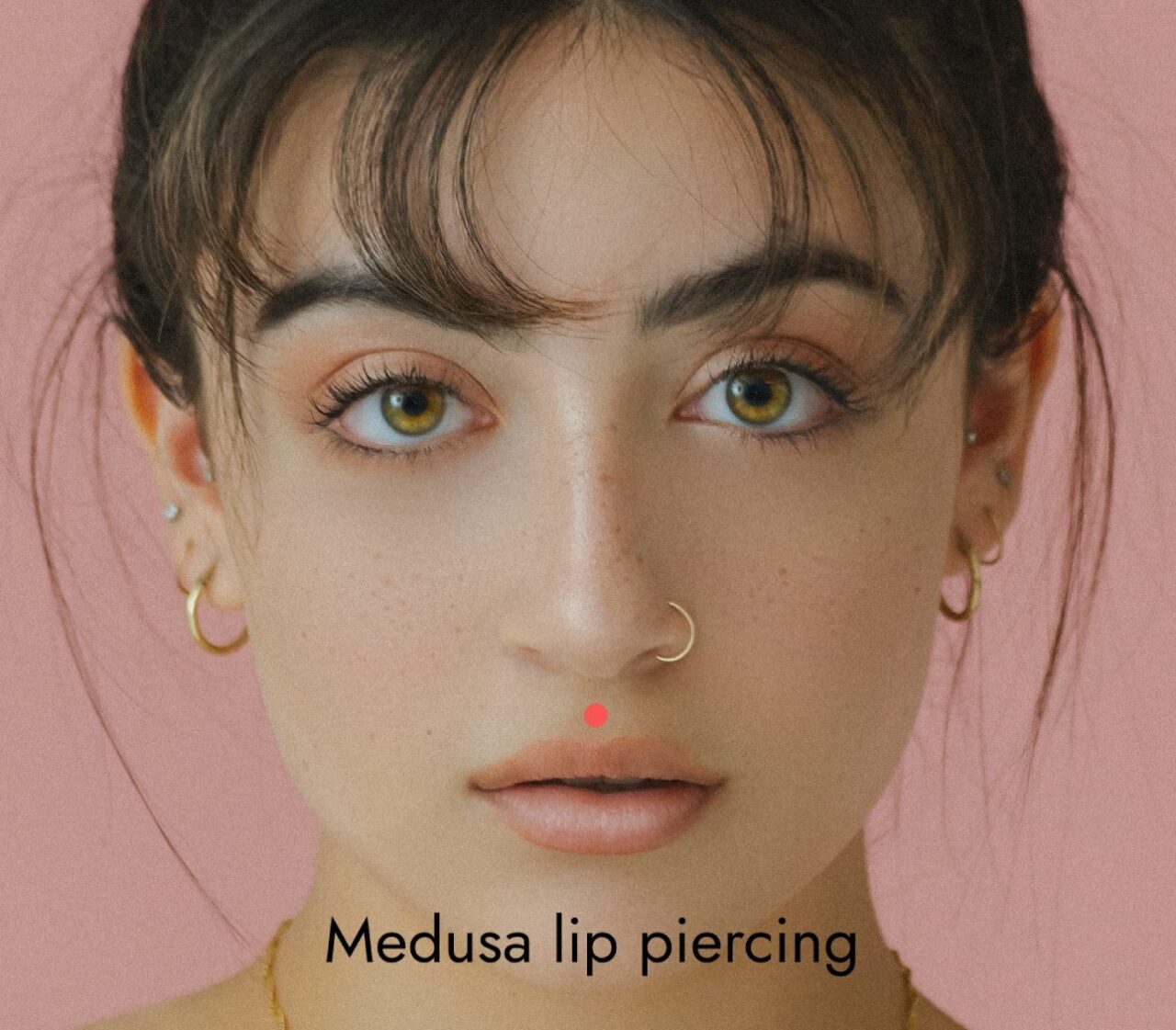What Is a Jestrum Piercing? Cost, Pain, Healing, Jewelry, Aftercare

Lip piercings offer a unique look with multiple different jewelry options that allow you to express yourself and your unique sense of style. What you may not realize, is there are many different types of lip piercings.
One worth considering is a Jestrum piercing (the Vertical Philtrum piercing), which is a vertical piercing that goes through the middle of your upper lip.
What Is a Jestrum Piercing?

A Jestrum piercing is also called a vertical Medusa piercing or a Vertical Philtrum piercing. It goes through the part of your upper lip called your philtrum. This is the dip just below your nasal septum.
This piercing ends up being visible with the lower portion sitting at the underside of your upper lip and the top portion sitting at your philtrum.

Image: Weeze Davis.
Variant
One variation of the Jestrum piercing is a double Jestrum piercing. Like its name implies, this involves two separate jestrum piercings. Instead of one vertical piercing in the middle of your upper lip, there are two vertical piercings positioned to the right and to the left of the middle portion of your lip.
As a finished look, there will be four areas where the jewelry is visible.
Jestrum Piercing vs. Medusa Piercing

A Jestrum lip piercing is similar to a Medusa piercing because they both are located at the philtrum.
However, while a Jestrum piercing usually uses a curved barbell visible at the top and bottom of your upper lip, the Medusa piercing is only visible at your philtrum. The Medusa piercing uses a labret stud with the back hidden inside your mouth, at the back of your lip.
Jestrum and Vertical Labret Piercings

Another variation to think about is a Jestrum piercing combined with a Vertical Labret piercing. This can be a great option for piercing enthusiasts who are looking to get multiple lip piercings that go well with one another.
While the Jestrum piercing goes through your upper lip, the Vertical Labret piercing goes through your bottom lip with one end of the jewelry visible at the underside of your bottom lip.
Paired together, your lip jewelry will be visible in three spots, placed in a symmetrical vertical row. In other words, when your mouth is closed, the accents of your jewelry will be visible at the top of your upper lip, between your lips, and just below your bottom lip.
Jestrum Lip Piercing Pain
On a scale from one to ten with one being little pain and ten being the worst, many would rate a Jestrum piercing at around a four. However, if your pain tolerance is low, you may experience a higher level of pain.
Keep in mind that choosing an experienced piercer can give you a better experience. They’ll be experienced in using sharp tools to puncture your skin quickly and efficiently.
Jestrum Piercing Healing
A Jestrum piercing will typically take around six to eight weeks to heal completely. You may realize your lip piercing heals quicker than this timeframe, or, it could take longer. If you don’t take care of your piercing or experience any complications, it could take much longer.
Jestrum Piercing Price
Jestrum lip piercings usually cost between $30 and $60, not including jewelry. The cost of your vertical lip piercing will depend on where you go, the experience level of your piercer, and the type of jewelry that you go with.
In most cases, it’s worth it to pay more to ensure a well-placed piercing with high-quality jewelry to support a smooth healing process.
Jestrum Lip Piercing Jewelry
When it comes to body jewelry, it’s important to follow recommendations for jewelry type and sizing. Different piercing areas will have different recommendations based on your body’s anatomy, the skin thickness, location, and other factors.
By going with the right jewelry, you’ll be more comfortable and are more likely to heal properly.
1. Jewelry Type: Curved Barbells (Banana Barbells)

Curved barbell piercing ASTM F136 implant-grade titanium internally threaded $15.9, SHOP NOW.
Jestrum piercings really only allow for a curved barbell. This is because of its location on your lip. The curved barbell features a ball or other accent on each end with one visible at your philtrum and one visible below your top lip.
If you go with something other than a curved barbell, you risk rejection and you’ll need to take the jewelry out and allow the piercing to close.
2. Jewelry Sizes
Jestrum lip piercings typically utilize 14-gauge (1.6mm) or 16-gauge (1.2mm) jewelry. The curved barbell length will depend on the thickness and size of your upper lip but will likely be 6mm (1/4"), 8mm (5/16"), or 10mm (3/8").
If you have a thin upper lip, you’ll likely want a 6mm (1/4") curved barbell. If you have a thicker upper lip, you’ll likely want a 10mm (3/8") curved barbell.
With the barbell, there will be an accent on each end. Accents vary in style and size. For example, you may opt for metal balls, spikes, diamonds, hearts, or something else. They can range in size with more petite accents measuring around 2mm and statement pieces measuring more toward 4mm.
3. Recommended Metals
Commonly recommended metals for Jestrum piercings include:
Implant-Grade Titanium
Implant-grade titanium lip jewelry is strongly recommended. It is lightweight, nickel-free, and won’t tarnish. It’s often recommended for those who are allergic to brass, nickel, and other metals common for jewelry.
14-Karat Gold
14-karat gold jewelry can offer an elevated look. However, they may be more pricey and could tarnish over time. Also consider if you have allergies, such as an allergy to gold.
Surgical-Grade Stainless Steel
If you opt for stainless steel, you should opt for surgical-grade steel. It often contributes to a smooth healing process and is extremely durable.
However, it does contain small amounts of nickel that could cause allergic reactions in those with skin sensitivities. Talk through all material options with your piercer to figure out what’s best for you and your skin.
Pros and Cons
Jestrum piercings (Vertical Philtrum piercings) have pros and cons to think about.
Some pros for you may include:
- Ability to have a double-pierced look with a single piercing
- Various barbell accent options to choose from
- Chance to pair with other lip piercings, like the medusa piercing
- Highly visible for those who want their piercing to stand out
- At or below the middle of the pain scale
Some possible cons you should think about are:
- Risk of tooth and gum damage
- Limited jewelry types to choose from
- Can interfere with eating, drinking, talking, and other oral activities
- Has a lengthy healing time of three to six months
Aftercare
- Don’t use your tongue to play with the jewelry.
- Opt for soft foods that aren’t overly spicy or acidic.
- Chew very carefully to avoid biting your lip jewelry.
- Avoid strenuous activities with your mouth until your piercings are fully healed.
- Avoid mouthwash with alcohol.
- Take care to avoid contaminating the piercing.
- Avoid touching it or applying makeup very close to it.
- Avoid getting in the water that might be dirty.
- Clean your piercing twice per day using a saline solution made for wound cleaning or soap and water to prevent infection.
- Avoid ointments as they prevent necessary air circulation.
- And of course, make sure to avoid snagging on clothes or towels.
- Wear loose clothing. Avoid wearing tight clothing or clothing that may rub against the piercing, as this can cause irritation and slow down the healing process.
- Use hypoallergenic jewelry like implant-grade titanium and 14- or 18-karat gold. Surgical-grade steel may contain small amounts of nickel that could cause allergic reactions.
- Don't move the piercing unless you're cleaning it. Pulling on a piercing early in healing is painful, but it also can get in the way of healing or damage the piercing itself.
- Wait until your piercing heals before changing out your jewelry.
- Watch for potential signs of infection and consult your piercer or doctor if it becomes infected.
Once your piercings are fully healed, you’ll be able to resume most of your daily habits. However, you may still find it difficult to eat certain foods or drink certain beverages that irritate the wounds. Be sure to talk with your piercer about concerns you may have.
How to Clean Jestrum Piercings?
It is recommended to use sterile saline that you buy from the store, rather than homemade saline, for cleaning your piercings. Homemade saline may be too salty for delicate piercing sites, leading to dryness and delayed healing.
Using mild, fragrance-free soap and water to clean your piercing site is also an option.
If you prefer homemade salt solution. You can start by mixing 1/2 teaspoon of non-iodized salt with one cup of distilled or boiled (for at least 20 minutes) water. You may choose to use less of the salt mixture like 1/4 to 1/8 teaspoon if you want a weaker solution that’s less likely to burn or sting. Stir the solution until it dissolves.
If you see signs of infection, you can also use antiseptic solutions, such as betadine, isopropyl alcohol, or diluted hydrogen peroxide. However, avoid using them for daily cleaning as they can damage cells.
Then proceed with the following steps to clean your piercing:
- Soak a cotton ball, a paper towel or non-plush cloth with the solution. Avoid fabrics that could snag and pull the jewelry or leave fibers behind. Gently saturate the piercing and cleanse it. Don't remove the jewelry!
- If you have a sterile saline wound wash that you buy from stores, then spay it while healing.
- Ensure you cleanse the piercing of any discharge or crusty material.
- Take clean gauze or cotton swabs and pat the area dry.
- Never scrub, poke, prod, or scrape at the piercing.
- Avoid eating, drinking, or applying makeup around the piercing directly after cleaning.
- Be sure to repeat this process at least 2-3 times a day or as advised by your piercer.
Your piercer should give you detailed instructions on how to keep your piercing clean once it has been placed.
Final Thoughts
Whether or not a Jestrum lip piercing is right for you truly depends on your preferences. Think about if you want a lip piercing and if you’re willing to dedicate time and effort toward cleaning and taking care of it.
Then, consider if you’re willing to undergo the piercing process and associated pain. If you are, explore different jewelry styles to determine if there are options that you enjoy.
Once you’re ready, set up an appointment with an experienced piercer and look forward to your new accessory.
Read More
What Is a Labret Piercing? Types, Pain, Cost, Healing, Jewelry, Sizes, and Aftercare
What’s an Ashley Piercing: Healing, Pain, Cost, Jewelry, Pros, and Cons
Side Labret Piercing: Cost, Healing Time, Pain, Meaning, Jewelry, Aftercare, Pros and Cons
Spider Bites Piercing: Cost, Healing, Pain, Jewelry, Aftercare, Pros and Cons

















